Pigeons (otherwise known as the rock dove) are a common, sturdy type of bird famously known for living alongside humans in cities and other urban areas.
| Latin Name | Columbia Livia |
| Also Known As | Pigeon, rock pigeon, rock dove, dove, domestic pigeon, feral pigeon, Columbidae. |
| Family | Columbidae |
| Types | There are over 350 different varieties of pigeon |
| Originate from | Southern Europe, North Africa, Asia |
| Where can you find them | Pigeons are one of the most populous birds in the world with an estimated 500 million+ globally, you can find them everywhere where humans are. The only places you don’t find pigeons are in extreme climates such as the Sahara desert, the Artic and Antarctica. |
In this guide, we discuss some of the essential parts of raising and keeping a pigeon.
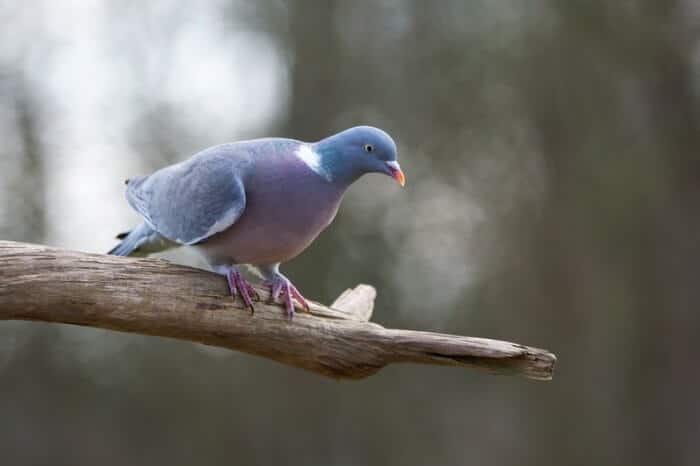
We review some basic pigeon facts, which include their anatomy, physical characteristics, social behaviors, interaction with humans, and navigation abilities.
The Columbidae Family
Here’s a fun fact about common city pigeons: they actually belong to the Columbidae family of birds, which includes quail doves, New World ground doves, Old World wood pigeons, and fruit doves.
This clues us in on a lesser-known tidbit about these urban-dwelling avians: pigeons are actually doves and vice versa.
That said, domestic white doves generally enjoy a more positive public image than rock pigeons, even though they differ only in color.
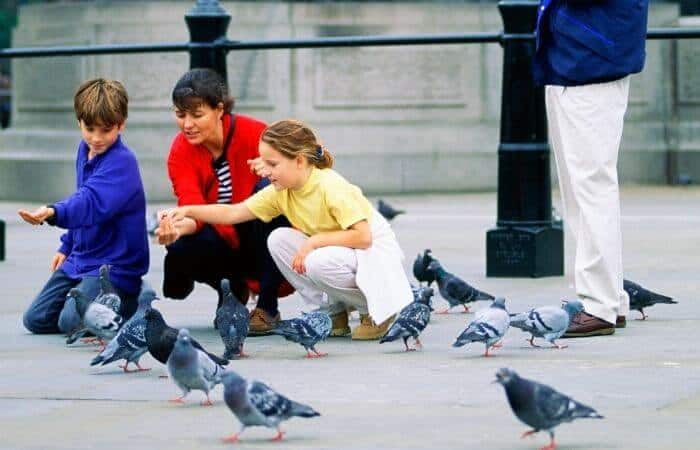
The modern city pigeon population is actually descended from a range of domesticated birds within the Columbidae family, most of them traceable to Old World rock pigeons.
Today, these diverse bird populations have habitats all over the world, from cliffs and major cities to artificial dwellings made by a few devoted pigeon fanciers.
Anatomy And Physical Characteristics
Because pigeons belong to a family of over 344 species of birds, their physical characteristics tend to manifest across a range of shapes, sizes, and colors.
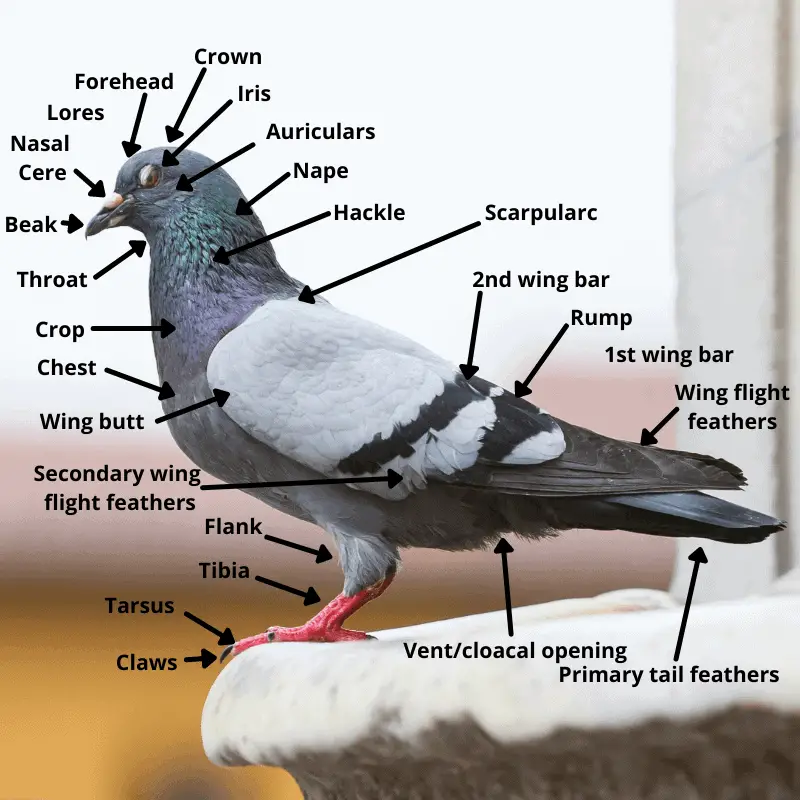
Generally speaking, pigeons can measure anywhere from 15 to 75 centimeters and weigh between 30g and 2000g (4.4lbs)!
The largest member of the pigeon family is the crowned pigeon of New Guinea, which rivals some turkeys in size. On the other hand, the smallest pigeon is the dwarf fruit dove, which measures roughly 5.1 inches with varying weight.
Feathers And Plumage
Pigeons have unique feathers characterized by a broad midsection, followed by an abrupt tapering toward the feather’s edge.
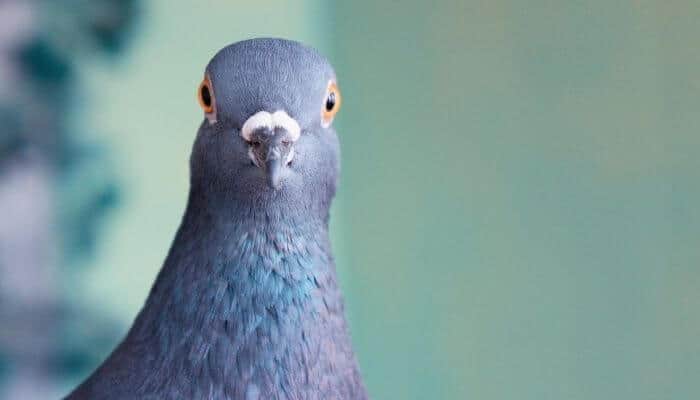
This construction is consistent throughout most pigeons’ throat feathers and neck feathers. Pigeon tail feathers may have an aftershaft or the appearance of a second, smaller feather branching off from the main shaft.
Flight
Rock pigeons, doves, and other members of the Columbidae family are considered excellent fliers because of their large wings, which allow them to take flight much faster than other types of birds. That means their broad, mighty wings are also an excellent survival tool.
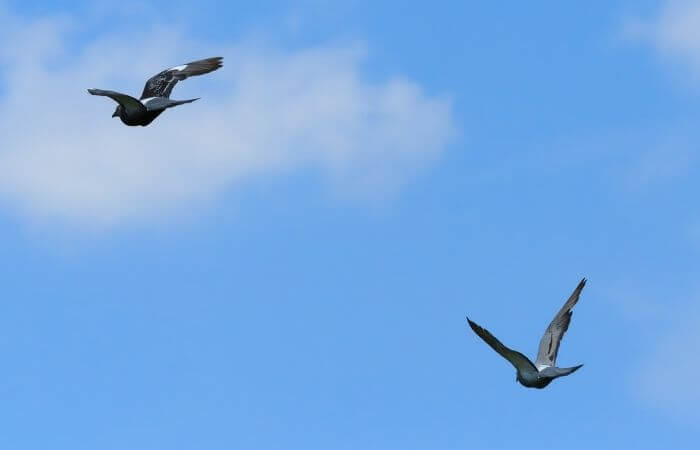
Generally speaking, most species of pigeons can fly at an average speed of 77.6mph, with some sources recording speeds of 92.5 mph.
Given their speed, it’s no wonder that these gregarious birds can make trips of 600 to 700 miles in a single day!
Social Behavior
A typical pigeon is highly social, and many of their preferred habitats nest a large group or flock.
Pigeons are extremely intelligent and will “imprint” upon their nest at around six months – which they, alongside their flock, will continue to return to for the rest of their lives despite the distance.
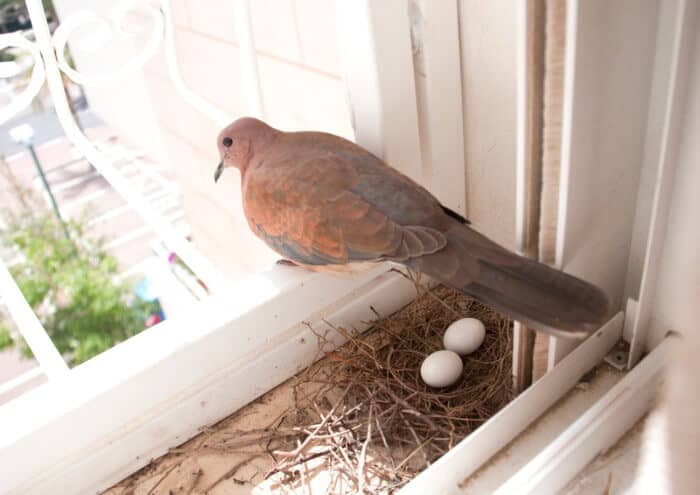
Because flocks of pigeons tend to stay together as a group and mate for life, food is the main determining factor of whether a pigeon will reproduce with others.
If their chosen habitats provide a steady source of food for these socially-inclined birds, female pigeons will lay two eggs up to six times a year!
This can be quite troublesome in cities and residential areas because feral pigeons tend to stubbornly build their nests on ledges, roofs, and trees.
Life With Humans
Various pigeon species are found in all corners of the world, and many of them have a long history of living alongside humans.
From ancient human civilizations to the modern coast guard, these birds have served as messengers, pets, and status symbols throughout time. For example, the domestic pigeon saw lots of action in WWI by carrying messages between army camps – sometimes saving hundreds of lives in the process.
Pigeons in recent times live more peaceful lives. Domestic pigeons are often kept as household pets or bred for competition and aesthetics.
Navigation Ability
If there’s anything these birds are known for (besides inhabiting large cities), it’s their inherent navigational capacity.
Pigeons have been used to carry messages throughout history – this would have been impossible without their incredible sense of direction. But what does science say about this extraordinarily intelligent bird?

An older study suggests that every pigeon has the supernatural ability to detect the earth’s magnetic waves, while others cite the sun as the secret to their navigational prowess. However, the answer is actually quite complicated.
Years of scientific study haven’t identified one specific thing that allows a typical pigeon to navigate long distances.
Rather, science seems to think it’s a combination of a pigeon’s sense of smell, visual recognition of terrain, internal “magnetic” compass, and intuitive understanding of its environment.
Pigeon Keeping And Care Guide
Many birds are raised and kept for sport, while others serve as feathered companions.
A domestic pigeon, like all other species of tamed bird, requires lots of planning and care.
Regardless of why you want one, you’ll need to brush up on the requisite knowledge before purchasing or adopting a bird.
Types Of Domestic Pigeon
While many pigeon species are found flying about in cities and urban areas, they’re often descended from escaped or released domestic birds that were bred for specific purposes. But what exactly are these purposes?
This section of our ultimate guide discusses some of the reasons people may keep and raise these docile creatures.
Flying Or Sporting Pigeon
Pigeon racing has been popular for hundreds of years, and today it’s still one of the biggest reasons people might keep and raise these birds. But how exactly do you race pigeons?

Unlike traditional animal races, pigeons are released from a set starting point to return to their home loft, which can be hundreds of miles away and differs per bird.
Traditional timing methods involve rings, timers, and manually setting clocks, while more modern races fit the competing bird with an RFID tag. These trackers are necessary because each bird must travel a distance that can range between 100km and 1000km.
Trainers and breeders raise a special kind of pigeon called a Racing Homer, which has been bred specifically for its speed and enhanced homing instinct. However, these birds can cost quite a bit because of their special breeding.
A pigeon may start racing as soon as six months and can continue to do so until they’re about ten years old. However, most birds have short-lived careers because of the physically demanding nature of the races.
King Pigeon
Size is the most significant indicator of a king pigeon, with many growing much larger than birds in flocks observed in cities or around rocky cliffs.
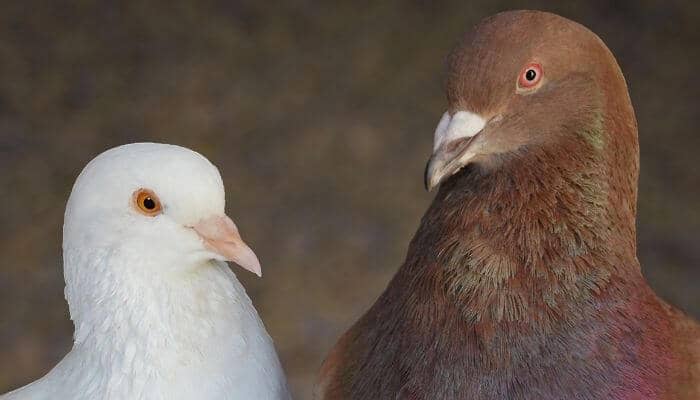
This bird species is specifically bred for utility purposes or to provide food for their breeders.
However, modern king pigeons enjoy much longer lives away from the action of live animal markets, and many of them nest alongside humans as pets.
Fancy Pigeon
As the name suggests, the fancy pigeon refers to a type of bird bred to emphasize specific characteristics – often occurring in more exclusive pigeon fancier circles.
Some breeders may choose to enter their birds into pigeon shows, similar to cat shows or dog shows, where they’ll be evaluated in specific areas.
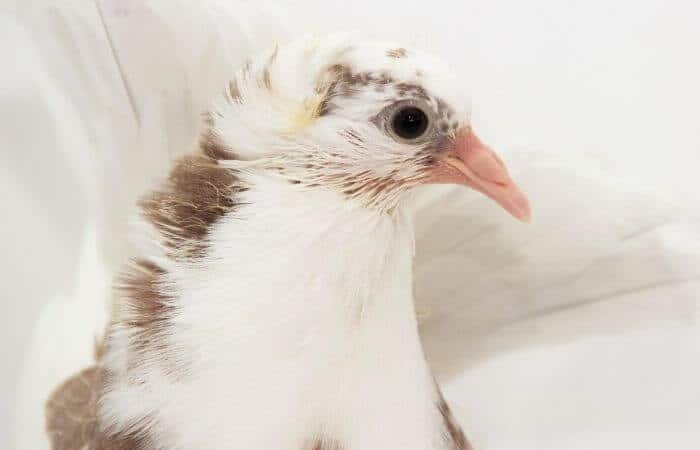
On the other hand, some pigeon enthusiasts may prefer to make their birds part of the family as beloved pets.
Because the moniker “fancy pigeon” is a catchall, many of these pigeons are quite unique and unlike any other bird you’ve seen!
With breeds like crimson-legged green pigeons, pouter pigeons with puffy throat feathers, fantail pigeons with colorful tail feathers, and the imposing English trumpeter pigeon, you’re sure to find a bird that captures your attention.
Utility Pigeon
Unlike their fancy and sporting counterparts, utility pigeons aren’t held to the same speed and beauty standards.
That’s because these pigeons are explicitly bred as a source of meat in many communities.
As a result, these pigeons are usually quite large and prized for their potential for fast growth and reproduction.
Homing Pigeon
Otherwise known as the “war pigeon” or “messenger pigeon”, these homing pigeons have seen a lot of action.
Humans have needed the services of homing pigeons many times throughout history.
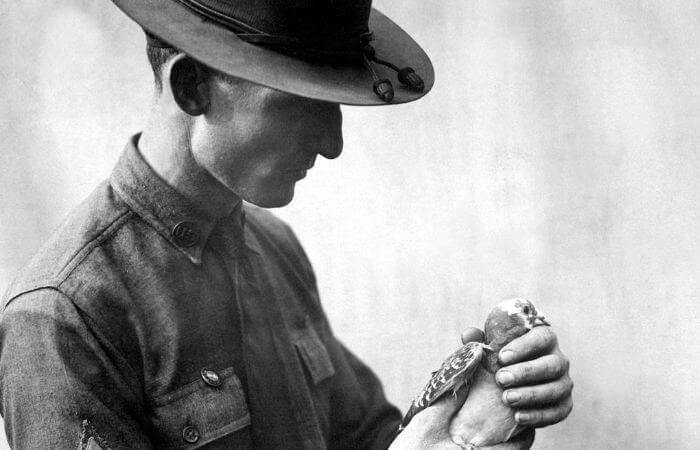
These services range from carrying crucial military information to serving as postal carrier birds to even smuggling narcotics across borders and into prisons.
Here’s a bit of homing pigeon trivia: while history tends to immortalize stories of powerful men and women, homing pigeons have also carved out a place for themselves.
One of the more renowned homing pigeons is a female bird named Cher Ami, who famously delivered a message that saved 194 people despite suffering from a gunshot.
She has since been decorated for her military service.
Domestic Pigeon Housing Options
Like other domestic animals, pigeons require room to nest, socialize with their flock (if you have more than one bird), and perch on artificial “cliffs” or ledges.
Pigeon homes are commonly referred to as “lofts”, and pigeon owners must make efforts to ensure their animals’ basic needs are met.
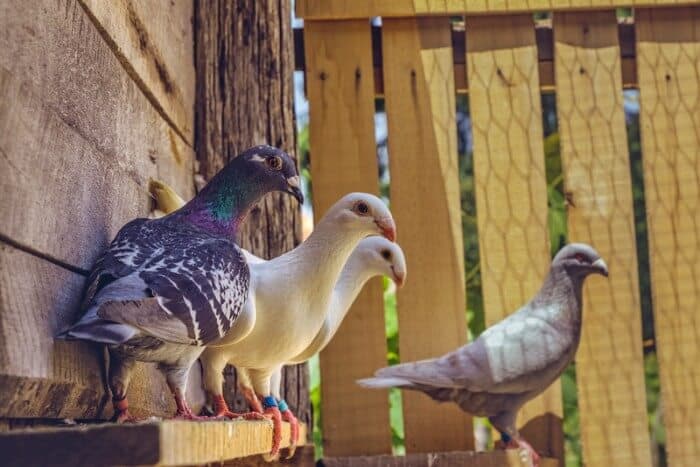
Specifically, the lofts have to be rodent-proof, cat-proof, and must have space for clean food and water dishes.
Here are some of the most common ways people house their domestic pigeons.
Multiple Pens
One of the most common ways pigeon fanciers will house their beloved birds is by segregating them into male and female pens. Doing this serves several purposes; it can:
- Control unwanted pigeon breeding
- Act as a physical separator between sick and healthy birds
- Encourage mated animals if they’re given enough food and space
Pigeon keepers may also want to use multiple pens to separate very young birds that haven’t developed any external indicators of their sex.
Landing Board Trap
If you’re the kind of person that fancies the idea of your bird having free range during the day, then setting up a landing board trap is an excellent way of keeping things in order.
Here’s how it works: in order to enter the loft, your bird must land on the trap door, which gives way under its weight and allows entrance into the enclosure. However, this only works one way, and birds can’t help themselves out.
While these lofts are well-suited to owners that want to give their birds more freedom during the day, we recommend doing this only after your birds have imprinted on their loft.
Fly Pen
Having ample space can really help your bird long-term, but not all owners have the freedom of letting them fly free during the day.
As a result, many pigeon keepers build fly pens in order to provide their precious birds with enough space to stretch their wings.
While fly pens are enclosed spaces, they usually have walls made from chicken wire or something similar to allow easy access to fresh air and sunlight.
Nesting Boxes
Here’s a pro tip when trying to keep several birds in order: separating mated pairs from the rest of the flock can help keep the peace, and that’s where nesting boxes come in.
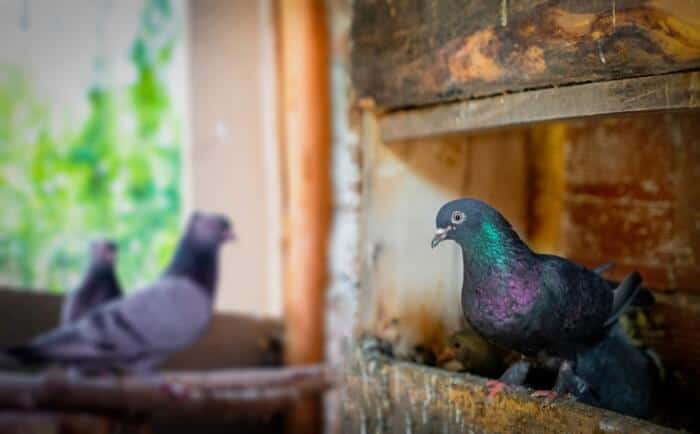
These little cubbies must measure at least 10 inches x 30 inches, although allocating more space for your birds can help them mate. Space can be vital for pigeon fanciers that intend to enter their birds into competition since happier birds tend to perform better over time.
Perches
Even though pigeons are generally considered sociable and docile birds, they can be quite territorial regarding their personal space in the loft. Perches are an efficient way to help your birds coexist peacefully.
Perches may resemble logs or come as wider, flat boards. We recommend installing more perches than necessary to allow enough space for each bird.
Diet And Healthcare
Feral pigeons usually eat a mix of seeds, vegetables, fruits, berries, and sometimes insects.
With this in mind, domesticated pigeons should be fed a diet that provides the same amount of nutrition.
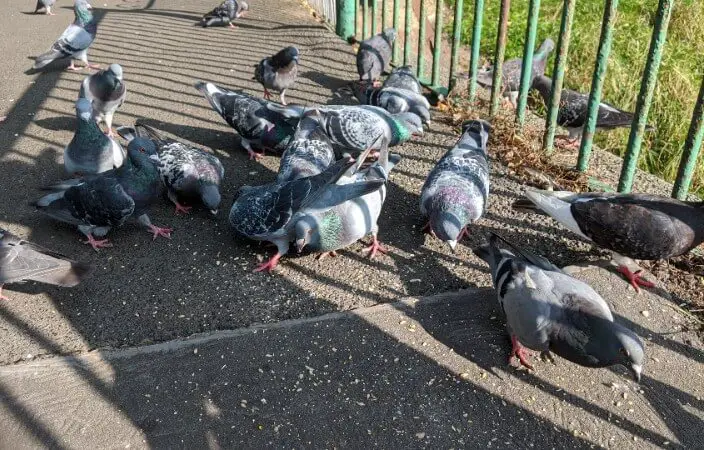
Luckily, you won’t have to go foraging for seeds or wild greens because most animal services sell pellets that are just as nutritious!
However, you can’t expect a healthy pigeon to survive off seeds or pellets alone. Instead, we recommend serving a 50/50 mix of freshly chopped vegetables mixed with pellets or store-bought seeds.
Pigeon Pants
Hygiene and cleanliness are essential for domestic pigeons, especially if you’re the type of owner that likes to keep them indoors.
Here’s a major drawback, though: pigeons tend to answer the call of nature wherever they’re standing, which can lead to some unfortunate (and smelly) accidents.
Fortunately, pigeon pants exist.
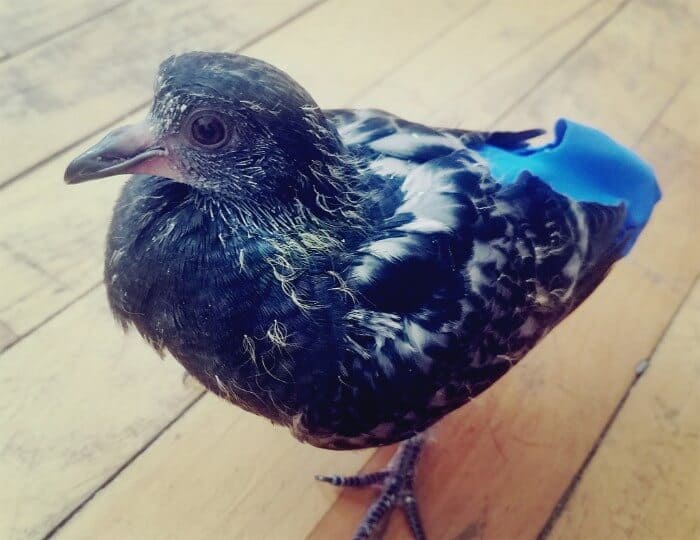
These cotton diaper-like harnesses catch your feathered friend’s poop right as it comes out, eliminating the need to scrub any surface while still leaving enough space for their tail feathers.
How To Handle A Pigeon
It’s easy to see why so many people are enraptured by pigeons. They’re sociable, docile, and much quieter than other pet birds.
However, they can also be quite fragile and may get injured if you don’t know how to handle them properly.
Here’s a tried and tested method of handling your pet pigeon without hurting it:
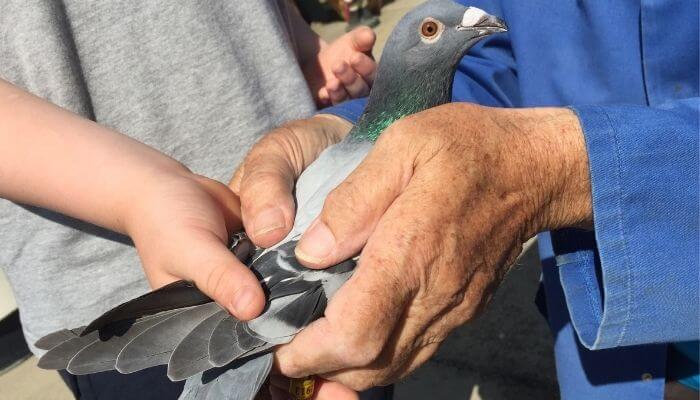
- Hold your dominant hand palm-up.
- Leave space between your pointer and middle finger and slowly slide your hand under the pigeon.
- Sandwich its legs between your fingers, and be sure not to clamp down too tight.
- Gently rest your thumb flat upon its wings.
- Slowly bring the bird closer to you, and use your free hand to support it completely.
Caring For Baby Pigeons
We know how it is – you find a baby bird seemingly abandoned by its flock, and you can’t help getting involved.
Top Tip: Use our pigeon age chart to work out the age of a baby pigeon.
However, baby pigeons are often better off left alone or handed off to rescue services that are equipped to help.
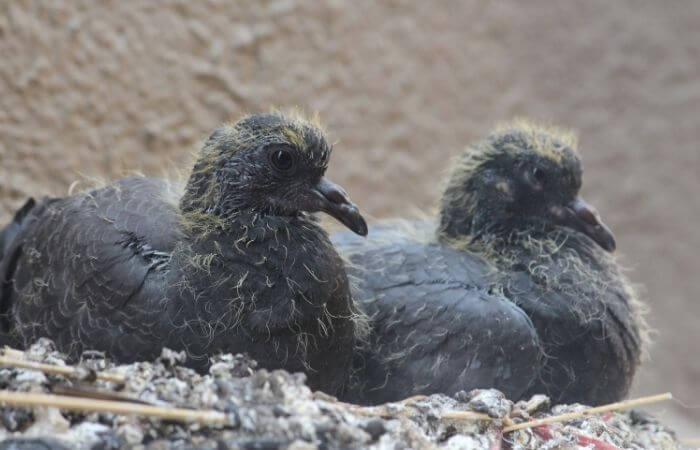
Or, if you’re in the business of raising birds, you may find yourself occasionally having to help feed your pet pigeon’s baby birds.
If this sounds like you, we’ll guide you through the process:
- Find baby bird formula: Adult pigeons provide “crop milk” to their young, which is packed with vital nutrients and antibodies for building strength and resistance. In order to help your baby bird grow, you’ll need to find the appropriate baby bird formula. If you’re unsure about what to get them, contact local rescue services for advice.
- Mix the formula with water: Once you’ve secured the baby bird formula, be sure to dilute it with water according to the included guide.
- Prepare a feeding syringe: After you’ve successfully packed the diluted formula into your syringe, secure the opening with vet wrap (a self-adhering bandage) or a dental dam. Afterward, cut a small hole at the entrance just large enough for the young bird to eat from.
- Ensure to warm the bird before feeding: Before initiating any feeding, be sure to put the baby pigeon in a box near a 40-watt bulb for warmth. Young bird offspring usually haven’t grown all their feathers and need the extra heat.
- Slowly reduce feeding sessions: Start by feeding your baby bird four times a day for the first week, then gradually reduce feeding sessions over time.
For more detailed information on caring for a baby pigeon, check out our dedicated guide.

This article was written by our qualified veterinarian Cristina.
This is part of our commitment to providing you with the most trustworthy veterinary advice for your pigeons.
Why Pigeons Make Great Pets
Whether you’re an experienced bird owner or looking to adopt your first feathered friend, pigeons are an excellent choice!
Despite their reputation as “dirty” birds that carry sicknesses, pigeons are actually exceptionally clean and tend to mesh with humans easily due to their manageable temperaments and sociable tendencies.
Here are a few reasons why pigeons make excellent pets.
They’re Quiet
Pigeons are relatively quiet, especially when compared to other popular types of pet birds like parrots and cockatiels.
Rather than a loud, ear-piercing squawk, pigeon noises are usually limited to a calming coo or the distinct fluttering of their wings.
They’re Friendly
Unless you’re a thrill-seeker or specialize in working with wild animals, you’ll want a feathery companion that likes people.
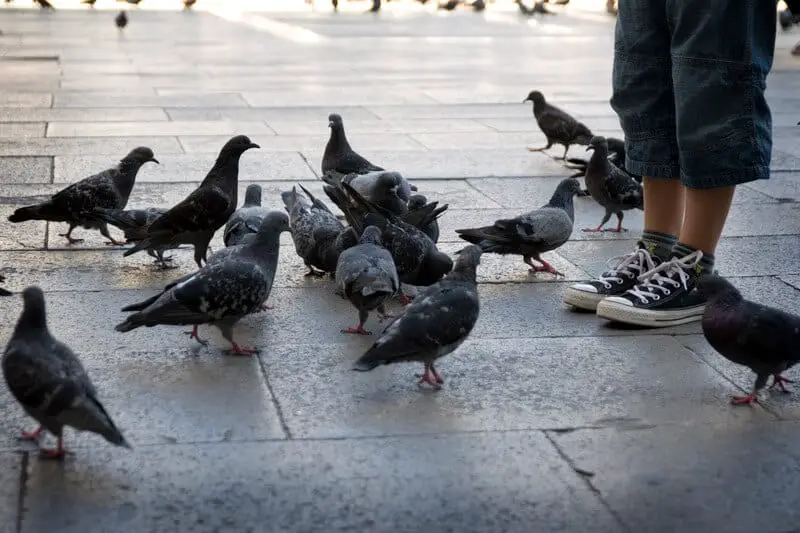
Because pigeons have lived alongside people for hundreds of years, they’ve developed an even-tempered nature that meshes well with most households – they’re even known to sit on shoulders when they trust someone!
Even when perturbed, pigeons tend not to resort to violence and will give you a light peck, at most.
They’re Relatively Affordable
Unless you are in the market for an extremely rare type of fancy pigeon, purchasing or adopting one is relatively affordable.
Even pigeon-specific food comes quite cheap!
They’re Extremely Intelligent
Pigeons are the opposite of “bird-brained”. In fact, they’re one of the few types of animals that can recognize themselves in a mirror, and that’s thanks to their intelligence.
This makes them extremely trainable, allowing them to compete in races, shows, or even work as a carrier pigeon!
They’re Hardy
When you commit to caring for an animal, you’ll want them to live long, full lives.
Pigeons are generally healthy birds that can live up to fifteen years in captivity, plus they tend to be quite resistant to common diseases with the right care.
Conclusion
The common pigeon has developed a bad reputation as “the rats of the sky” and disease carriers, but they actually make for excellent pets and companions.
They’ve lived alongside people as mail carriers, show birds, and valued members of human families, and they continue to delight avian enthusiasts to this day.
With the right mix of time, research, and effort, pigeons can be a fantastic addition to your family, too!
Sources:
